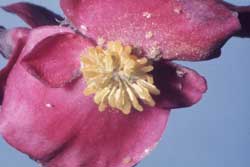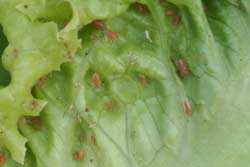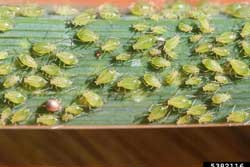Aphids
Aphids are sucking insects which draw great quantities of sap, causing leaves and stems to become distorted. This distorted growth may be mistaken as herbicide injury. Some plant sap is excreted as honeydew, which makes the plant sticky. Sidewalks, cars, and patio furniture may become wet with honeydew. A sooty mold often grows in the honeydew and blackens stems, leaves and other surfaces. Aphids attack a wide variety of plants; most species feed on one or a few species of closely related plants.
Aphids may be green, black, brown, red, pink, or some other color. These pear-shaped insects are slow moving and range in size from 1/16 to 1/8 inch long. Dense colonies of aphids may be found along stems, in and around the roots, or on the underside of a leaf. Several generations may occur and populations can build up quickly.
Click on images to view full-size
Identification and Control Information
- Fact Sheet: Sucking Insects That Affect Vegetable Plants—University of Maine Cooperative Extension
- Fact Sheet: Aphids (PDF)—Insect Diagnostic Laboratory, Cornell University
- Garden Facts: Vegetable Aphids (PDF)—University of Wisconsin Extension
- Less-Toxic Pest Management: Controlling Aphids in Your Garden (PDF)—www.ourwaterourworld.org
Species Specific Resources & Deeper Reading
- Rice Root Aphid (Rhopalosiphum rufiabdominale), a species associated with the roots of cotton, grasses, and sedges, has recently confirmed as a pest on the roots of cultivated Cannabis sativa, including in Maine – Open Access Research, Journal of Integrated Pest Management
More Information
- Integrated Pest Management of Roses—Cornell University Department of Horticulture
[Photos, left to right: Jim Baker, North Carolina State University, Bugwood.org; Whitney Cranshaw, Colorado State University, Bugwood.org; Whitney Cranshaw, Colorado State University, Bugwood.org]


